Basics of object oriented programming interview tips for Java
- 1. Basics of Object Oriented Programming Dr.A.Martin, ME, Ph.D. Assistant Professor, Dept. of Computer Science, School of Mathematics and Computer Sciences, Central University of Tamil Nadu, Thiruvarur, Tamilnadu-610 101.
- 2. Agenda • Structured Programming • Limitations in Structured Programming • Object Oriented Programming • Classes and Objects • OOP’s Principles • Static and Non Static Data • Accessibility • Exception Handling and Templates
- 3. Structured Programming • It employs a top-down design model - map out the overall program structure into separate subsections. • A defined function or set of similar functions is coded in a separate module or sub module. • Most famous for removing or reducing flaws on the GOTO statement. • E.g. C – The Programming Language.
- 4. Limitations in structured programming • Data hiding • Debugging of programs are hard – Not Possible to handle run time errors and future enhancements. • Non Flexibility of Code – In procedural programming, parts of code are interdependent. – This interdependency makes modification & manipulation of a particular part of the program without affecting other parts.
- 5. Limitations in structured programming • Software development period is high. • Software cost is high. • If end user requirement changes a big modification is needed in software • More stress laid on procedures not on data
- 6. Object Oriented Programming • In object oriented programming data and the instruction for processing that data are combined into a self-sufficient “object” that can be used in other programs. • It is a programming methodology used to solve and develop complex problems by using oops principles. • Real world objects • Software Objects • Mapping of Real objects to software objects.
- 7. Class and Objects • A Vehicle – A Car • Mechanism – Break System, Radiator Cooling System, Auto Door Lock, Air Conditioning, Safety System, Security Mechanism, Gear Mechanism, etc., • Spare Parts - Tires, Number of Tires, Head Light, Density of air in tiers, Switch, window, door, Number of windows and doors, Number of seats. • Car created with mechanism and spare parts. • So many types – all from same car – differs in flexibility and luxuries.
- 8. • Class – The bundling of data and functions that acting on data on a single place. • Class is a mould upon which objects are created. • The logical thing class is invoked by the real thing object. • The instance of the class is object.
- 10. Encapsulation – A rigid wall • The binding of data and functions together to achieve information hiding and modularity. • Not allowed to enter. • Not same kind of restriction to everyone. • We want to some level of flexibility. • Accessibility – access specifiers • Public , Private and Protected • Default.
- 11. Inheritance It allows the creation of hierarchical classifications. Using inheritance, you can create a general class that defines common properties. This class may then inherit by more specific classes, each adding only those things that are unique to the inheriting class. The process of creating new classes from existing classes. A class that inherited is referred to as a base class. The class that does the inheriting is called derived class.
- 12. Benefits, New classes can be derived by the user from the existing classes without any modification. It saves time and money. It reduces program coding time. It increases the reliability of the program.
- 13. Types of Inheritance Single : one base class and derived class Multiple : Many base class to one derived class Multilevel : derived classes in a sequential order Hierarchical : one base class and many derived class Hybrid : A class derived from a base class and an inheritance class
- 14. Polymorphism • One interface with different forms • Moving of a vehicle – Energy required. • Energy available in different forms • Fuel – Petrol, Diesel, Solar, Electric – Battery. • Objective – Moving – achieved with different ways. • Compile time polymorphism and Run time polymorphism.
- 15. Compile time polymorphism and Run time polymorphism. • Function overloading Same function with different arguments Sum(int a ,int b) Sum (double a, double b) Sum (double a, double b, double c) Sum (int a, long b) Need not worry about return type.
- 16. Function overriding • Both base class and sub class have the identical function. • Same name, same number of arguments, same data type. • The function which is available in derived class overrides the function in base class – called as function overriding.
- 17. Static and Non Static Data • Single copy shared by all instances • Individual copy for every object • How objects created for a class. • How memory is allocated and reclaimed for objects. • Garbage collection. • Constructor and Destructor. [C++] • Constructor and Garbage Thread [Java].
- 18. Accessibility Levels • Public, Private and Protected. [C++] • Public, Private and Protected and default. [Java]
- 19. this pointer • Avoids name collision • Refers the current object
- 20. Templates • Templates are mechanism that make it possible to use one function or class to handle different data types. • Function Template • Class Template


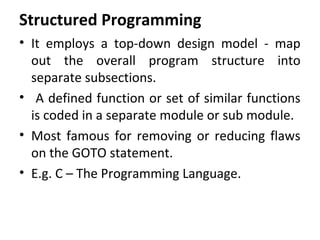
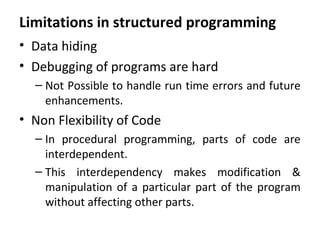

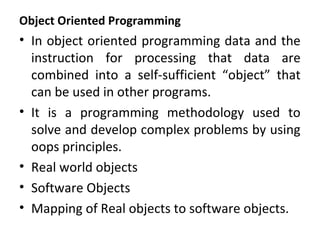




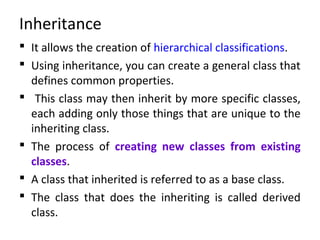


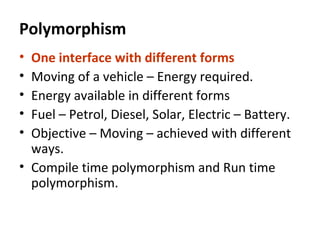


![Static and Non Static Data
• Single copy shared by all instances
• Individual copy for every object
• How objects created for a class.
• How memory is allocated and reclaimed for
objects.
• Garbage collection.
• Constructor and Destructor. [C++]
• Constructor and Garbage Thread [Java].](https://image.slidesharecdn.com/basicsofobjectorientedprogramming0912-170816163506/85/Basics-of-object-oriented-programming-interview-tips-for-Java-17-320.jpg)
![Accessibility Levels
• Public, Private and Protected. [C++]
• Public, Private and Protected and default.
[Java]](https://image.slidesharecdn.com/basicsofobjectorientedprogramming0912-170816163506/85/Basics-of-object-oriented-programming-interview-tips-for-Java-18-320.jpg)

